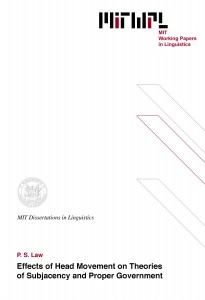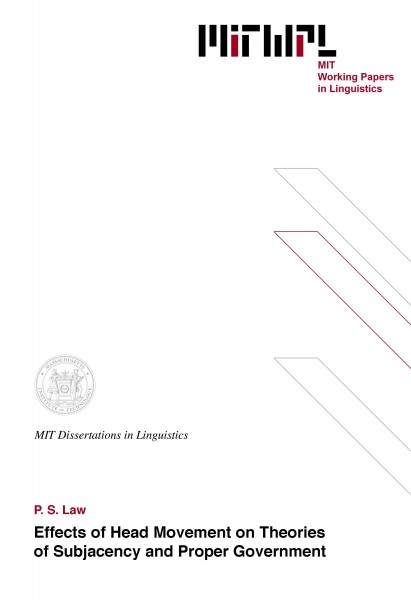Effects of Head Movement on Theories of Subjacency and Proper Government
P. S. Law, 1991
This dissertation offers a perspective from which to view the relationship between extraction and head-movement. In particular, it claims that bounding theory must take syntactic head-movement into account in defining bounding domains, and that the possibility of subject extraction is related to abstract verb movement to C, which is argued to be a consequence of the interaction between the Principle of Full Interpretation and various other principles of the grammar.
It is suggested that bounding domains be defined with respect to head-movement in that a potentially bounding category can be subsumed under another if their heads are morphologically merged. Evidence is presented to show that VP can be bounding in general, and that cases where the bounding effect is seemingly absent are due to head-movement. It is also shown how this conception of bounding domains fits into a theory of bounding with two parameters which can annul bounding effects of maximal projections by complementation. A principled explanation obtains for why certain combinations of categories as bounding domains are possible, and why some others are not. The predicted four types of languages with respect to bounding variations are all attested. It is also argued that successive-cyclic movement is strictly constrained by structure-preservation.
The apparent lack of the that-trace effect in some languages is suggested to have a principled account in terms of abstract verb movement to C, which is either a consequence of the interaction of the Principle of Full Interpretation and a theory of expletive replacement, or is due to some language-particular property like verb-second constraint in most Germanic languages requiring movement of the finite verb to C to hold at LF, if it is not already there at S-structure. One desirable consequence that immediately follows is that the class of proper head-governers can now be restricted to all and only lexical categories. It is suggested that abstract verb movement to C in relative clauses is independently justified by theory of predication, which requires a lexical category to fill the head of a constituent in order for it to function semantically as a predicate. Consequently, the subject trace is properly head-governed by the verb in C. The possibility of abstract verb movement to C thus explains in a uniform way the anti-that-trace effect in relative clauses, and the that-trace effect in complement clauses, without the assumption that the complementizers in these two types of constructions are different entities.
Thesis Supervisor: Noam Chomsky
Title: Institute Professor
Chapter 1 Overview
1.1 Introduction 9
1.2 A generative model of language 10
1.3 Notational conventions 13
1.4 Fundamental notions and definitions in syntactic theory 14
1.4.1 Syntactic features 14
1.4.2 Indexation 15
1.4.3 Syntactic representations 17
1.5 Modules of grammar 19
1.5.1 X-theory 20
1.5.2 Hierarchical relations 24
1.5.3 Theta theory 24
1.5.4 Theory of feature selection 28
1.5.5 Case theory 31
1.5.6 Theory of government 34
1.5.7 Theory of proper government 36
1.5.8 Bounding theory 37
1.5.9 Binding theory 38
1.6 Theory of agreement 40
1.6.1 Spec-head agreement 40
1.6.2 Non-Spec-head agreement 43
1.7 Morphological spell-out rules 47
1.8 LF-objects 49
1.9 Overview of the chapters 50
1.10 Abbreviation conventions 52
Appendix: A note on the projection principle 53
Chapter 2 Syntactic verb movement and bounding theory
2.1 Introduction 55
2.2 Empirical adequacy of the subjacency condition 56
2.3 Analysis for bounding variations 59
2.3.1 Bounding parameters 59
2.3.2 Boundedness of clausal projections 61
2.3.3 Boundedness of nominal projections 63
2.3.4 Boundedness of VP 64
2.4 Defining bounding domains: head-movement 68
2.4.1 Clause structure and extraction in Welsh 68
2.4.1.1 VP-internal subject hypothesis 69
2.4.1.2 Wh-movement in Welsh 72
2.4.1.3 On successive-cyclic adjunction and structure
preservation 82
2.4.2 Effects of head-movement on bounding domains 86
2.4.2.1 Welsh VP 86
2.4.2.2 English and Italian VP 88
2.4.2.3 Problems with English and Italian auxiliaries 92
2.4.2.4 Welsh particles yn, wedi, newydd and heb 95
2.4.2.5 Boundedness of functional projections 101
2.4.3 Some problems with gerunds 105
2.5 Subjacency in Scandinavian languages 111
2.5.1 Island violations in Scandinavian languages 111
2.5.2 Extraction out of verb-second clauses 114
2.6 Conclusions 119
Appendix: A note on preposition stranding 121
Chapter 3 Abstract verb movement and complementizer agreement
3.1 Introduction 125
3.2 Complementizer agreement in West Flemish 126
3.2.1 Constructions with no wh-movement 130
3.2.1.1 Co-indexing of C and INFL 131
3.2.1.2 Selection of INFL by C 134
3.2.1.3 Stranded V analysis 137
3.2.1.4 Expletive replacement analysis 140
3.2.2 Constructions with wh-movement 144
3.2.2.1 West Flemish relative clauses 144
3.2.2.2 West Flemish die as a complementizer 148
3.3 Complementizer agreement in French 154
3.3.1 Spell-out of traces 161
3.3.2 Improper movement 166
3.4 On the feature [+/-PRED] and [+/-OP] 168
3.4.1 Distinction between operatores and non-operators 169
3.4.2 Differences between interrogative and relative operators 170
3.4.3 Typology of DPs 173
3.5 Agreement in CP 174
3.5.1 Irish mutation in relative clauses 177
3.5.2 On Kinande Spec-head agreement in CP 181
3.5.3 Lack of agreement with adjuncts 183
3.6 Conclusions 189
Chapter 4 Abstract verb movement and proper government
4.1 Introduction 191
4.2 Antecedent-government and the that-trace effect 192
4.3 On head-government 199
4.3.1 Head-government by verbs in INFL 200
4.3.2 Head-government by complementizers 205
4.3.3 The class of proper head-governers 206
4.4 Expletive replacement and proper government 213
4.5 Parametric variations in the that-trace effect 218
4.5.1 Expletive deletion and proper government 219
4.5.2 Complementizer agreement and the verb-second property 221
4.5.3 The lack of the that-trace effect in verb-second languages 223
4.5.4 Overt and abstract verb movement to C 228
4.5.5 The that-trace effect and the Principle of Last Resort 233
4.6 Consequences of the conjunctive ECP 234
4.6.1 Extraction out of wh-islands in West Flemish 235
4.6.2 Extraction in Vata 238
4.6.2.1 Extraction of arguments 238
4.6.2.2 Extraction of adjuncts 244
4.6.3 Long-distance dependency in Welsh 249
4.6.4 Argument/adjunct distinction 256
4.6.4.1 Head-government of adjuncts 257
4.6.4.2 Intermediate traces and the ECP 259
4.6.4.3 Condition on A"-dependency 261
4.6.4.4 Principle of adverbial interpretation 263
4.6.4.5 Antecedent-government of adjuncts 269
4.6.5 Long-distance subject extraction in English 273
4.7 Subject extraction in West Flemish and Dutch interrogatives 280
4.7.1 On West Flemish expletive er 280
4.7.2 On Dutch expletive er 285
4.8 Conclusions 290
Chapter 5 Abstract verb movement and theory of predication
5.1 Introduction 297
5.2 Some issues in relative clauses 298
5.3 Abstract and agreeing complementizers 301
5.4 Predication theory and relative clauses 309
5.4.1 The structure of relativized noun phrases 309
5.4.2 The semantics of relative clauses 314
5.4.3 The internal structure of relative clauses 316
5.4.3.1 On relative operators 316
5.4.3.2 Operators in Hebrew relative clauses 321
5.4.3.3 The distribution of wh-operators 328
5.4.3.4 The distribution of empty operators 330
5.4.3.5 The Predicate Principle 333
5.5 Head-government in relative clauses 336
5.5.1 Wh-relatives 337
5.5.2 Zero-relatives 338
5.5.3 That-relatives 340
5.6 The that-trace effect versus the anti-that-trace effect 341
5.6.1 The that-trace filter 342
5.6.2 Minimality in relative clauses 344
5.6.3 Relative that as an agreeing complementizer 344
5.6.4 The complementizer that as an expletive 352
5.7 Short subject extraction 354
5.7.1 Vacuous movement of subjects 355
5.7.2 Extraction of non-local subjects and do-support 359
5.7.2.1 The Adjacency Condition for morphological
support 360
5.7.2.2 Short subject extraction and the ECP 363
5.7.2.3 ECP effects in main clause 366
5.7.3 Main clause short subject questions as IPs 371
5.7.4 The root-clause condition and head-government 373
5.7.5 Embedded short subject questions 376
5.8 Agreement in relative clauses 380
5.8.1 Agreement chains and predication 381
5.8.2 Agreement linking 383
5.9 Conclusions 390
Appendix: A note on short subject zero-relatives 392

